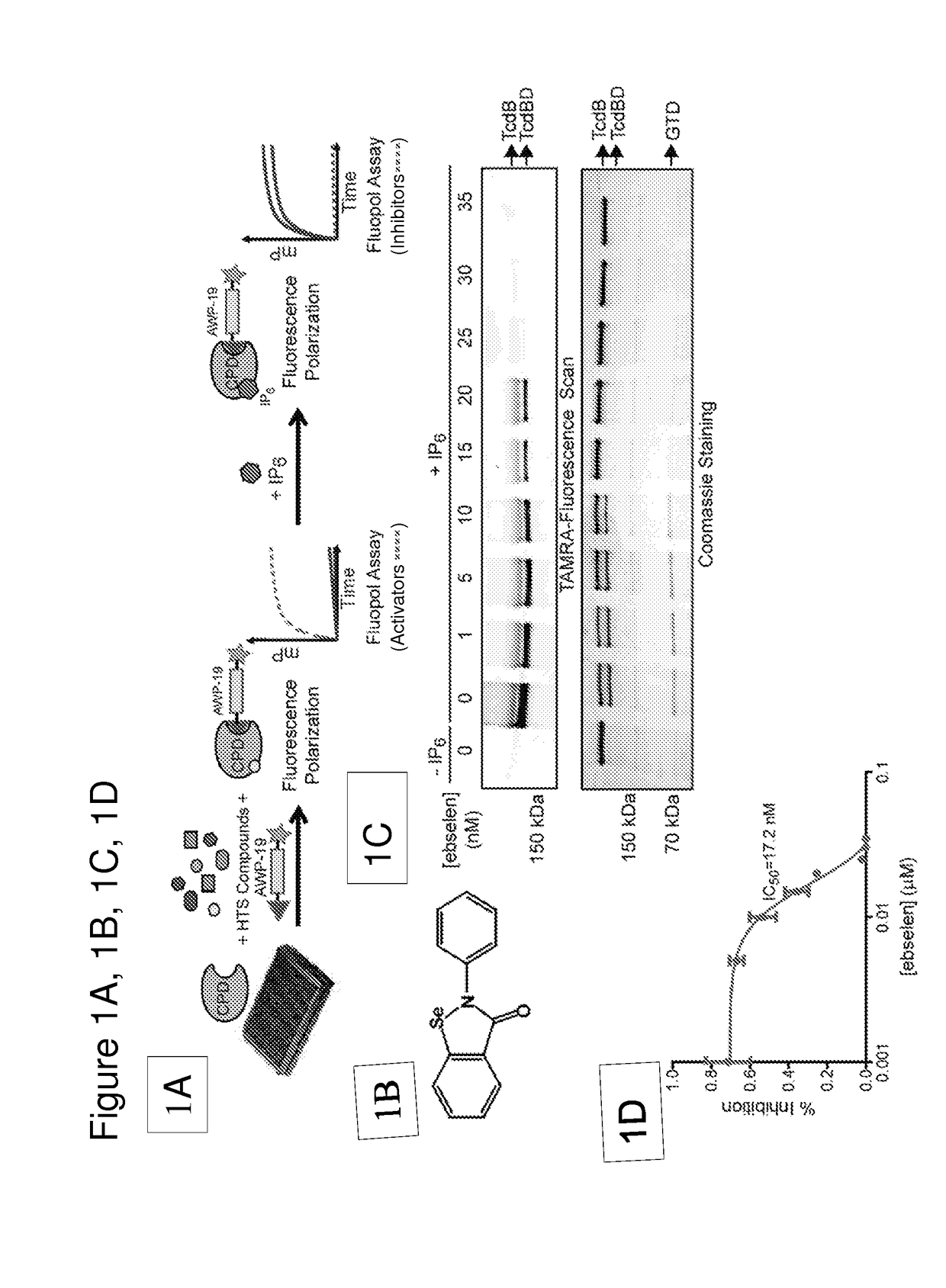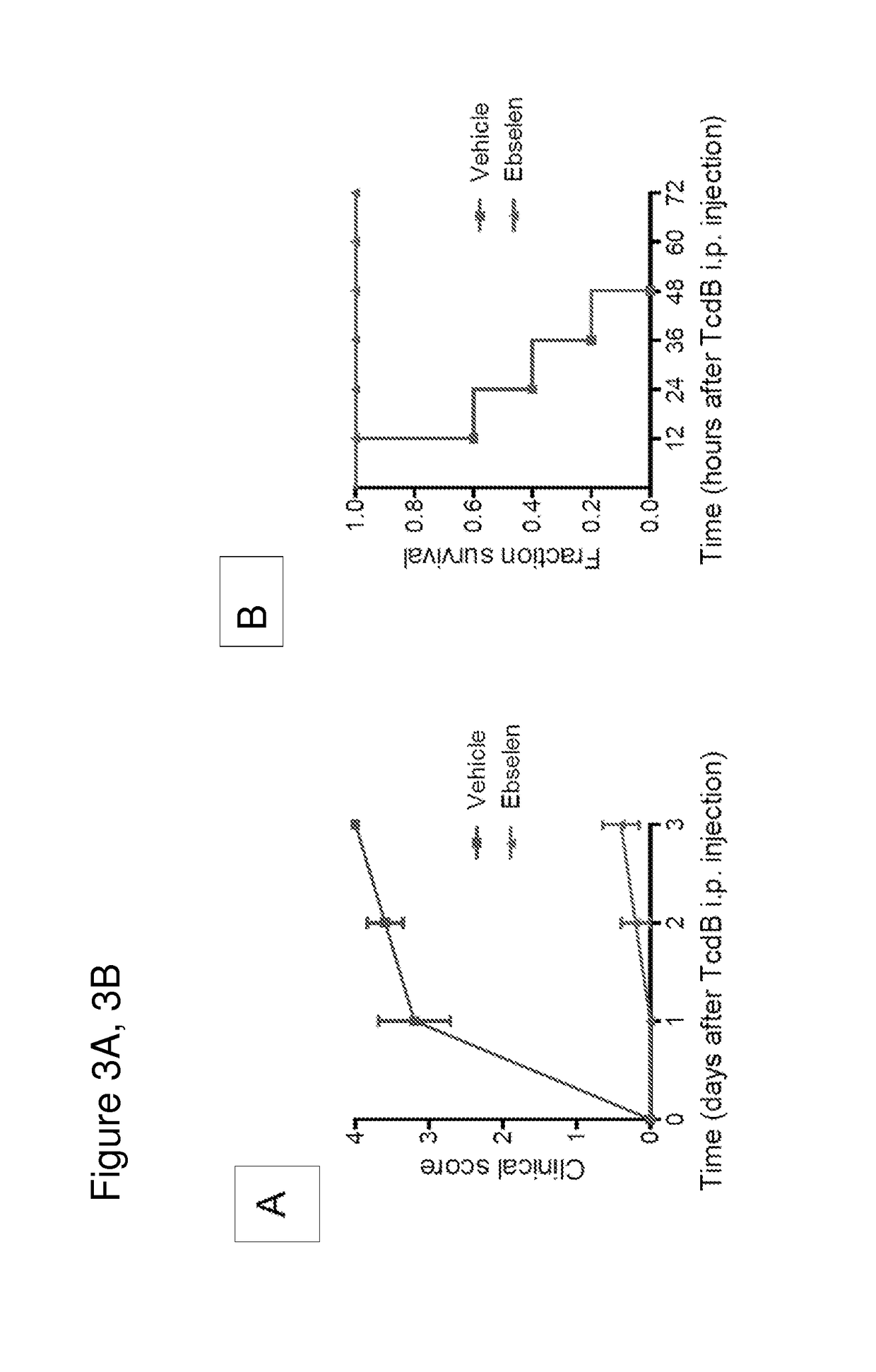Use of small molecules for the treatment of clostridium difficile toxicity
a technology of clostridium difficile and small molecules, applied in the field of infectious diseases, can solve the problems of increasing the number of infections, causing significant public health threats, and the long-term effects of human health remaining uncharacterized
- Summary
- Abstract
- Description
- Claims
- Application Information
AI Technical Summary
Benefits of technology
Problems solved by technology
Method used
Image
Examples
example 1a
ghput Screen for Inhibitors of TcdB CPD
[0111]We have developed a fluorescence polarization high throughput screen (HTS) to identify inhibitors of the TcdB CPD (FIG. 1A). This screen makes use of a fluorescent small molecule activity based probe that covalently binds to the active site cysteine residue of the CPD to measure enzyme activity2,23. The unbound fluorescent activity based probe (AWP-19) produces low fluorescence polarization (mP). Probe binding to IP6-activated CPD results in an increase in mP and the difference in bound and unbound mP values can be measured on a plate reader. Thus, the probe allows screening for both inhibitors and activators in an HTS format. Using this approach, we screened a large library of bioavailable drugs considered clinically safe but without an FDA approved use28 as well as the National Institutes of Health Clinical Collection. The compounds were screened against the recombinantly expressed cysteine protease domain. The screen identified a numbe...
example 1b
alogs Having TcdB Protease Inhibition
[0114]The data are for a competition based assay with an active site probe; it can be seen that some compounds in Table 2 are actually more potent than ebselen.
TABLE 2Name and rank: 1 =most inhibitionIC50(annotatedNo.(uM)Structure / MF / MWinhibitors only)MG-332.7042,2′-diselane-1,2- diylbis[N-(2,4- difluorophenyl) benzamide]; 1MG-563.9462,2′-diselane-1,2- diylbis[N-(3- methoxyphenyl) benzamide]; 2MG-123.9762,2′-diselane-1,2- diylbis[N-(2- chloro-4- methylphenyl) benzamide]; 3MG-384.7432,2′-diselane-1,2- diylbis[N-(2- chloro-4- methylphenyl) benzamide]; 3MG-1744.8642-(2- hydroxyphenyl)-1, 2-benzoselenazol- 3-one; 5MG-134.8972-(4- methylphenyl)-1,2- benzoselenazol-3- one; 6MG-314.9172,2′-diselane-1,2- diylbis[N-(2- fluorophenyl) benzamide]; 7MG-435.0922,2′-diselane-1,2- diylbis[N-(3- chloro-4- fluorophenyl) benzamide]; 8EBSELEN5.1362-phenyl-1,2- benzoselenazol-3- one; 9MG-25.5772-(2-methoxy-5- methylphenyl)-1,2- benzoselenazol-3- one; 10MG-615.9732,2′...
example 2
fficacy of Ebselen Against TcdB
[0116]To determine the efficacy of ebselen against the toxin in vivo, two groups of mice (5 mice per group) were injected intra peritoneally (i.p.) with either 25 ng TcdB or with 25 ng TcdB that had been pretreated with 100 nM ebselen. Mice were monitored for three days for clinical signs of toxin action and overall survival. Mice treated with the ebselen-pretreated TcdB had a 100% survival rate with no significant changes in vital signs (FIG. 3A) while the control group showed significant signs of toxicity (ruffled fur, significantly decreased activity, peritoneal swelling, and hunched position) by 12 hours after toxin injection. Clinical scoring throughout 72 hours was assessed as follows: 0=healthy animal, 1=ruffled fur and BAR (bright, alert, and reactive), 2=ruffled fur, hunched and QAR (quiet, alert, and reactive), 3=ruffled fur, hunched, inactive, dehydration, 4=moribund. Overall, the untreated group had a 60% mortality rate within the first 24 ...
PUM
| Property | Measurement | Unit |
|---|---|---|
| pH | aaaaa | aaaaa |
| volume | aaaaa | aaaaa |
| volume | aaaaa | aaaaa |
Abstract
Description
Claims
Application Information
 Login to View More
Login to View More - R&D
- Intellectual Property
- Life Sciences
- Materials
- Tech Scout
- Unparalleled Data Quality
- Higher Quality Content
- 60% Fewer Hallucinations
Browse by: Latest US Patents, China's latest patents, Technical Efficacy Thesaurus, Application Domain, Technology Topic, Popular Technical Reports.
© 2025 PatSnap. All rights reserved.Legal|Privacy policy|Modern Slavery Act Transparency Statement|Sitemap|About US| Contact US: help@patsnap.com



